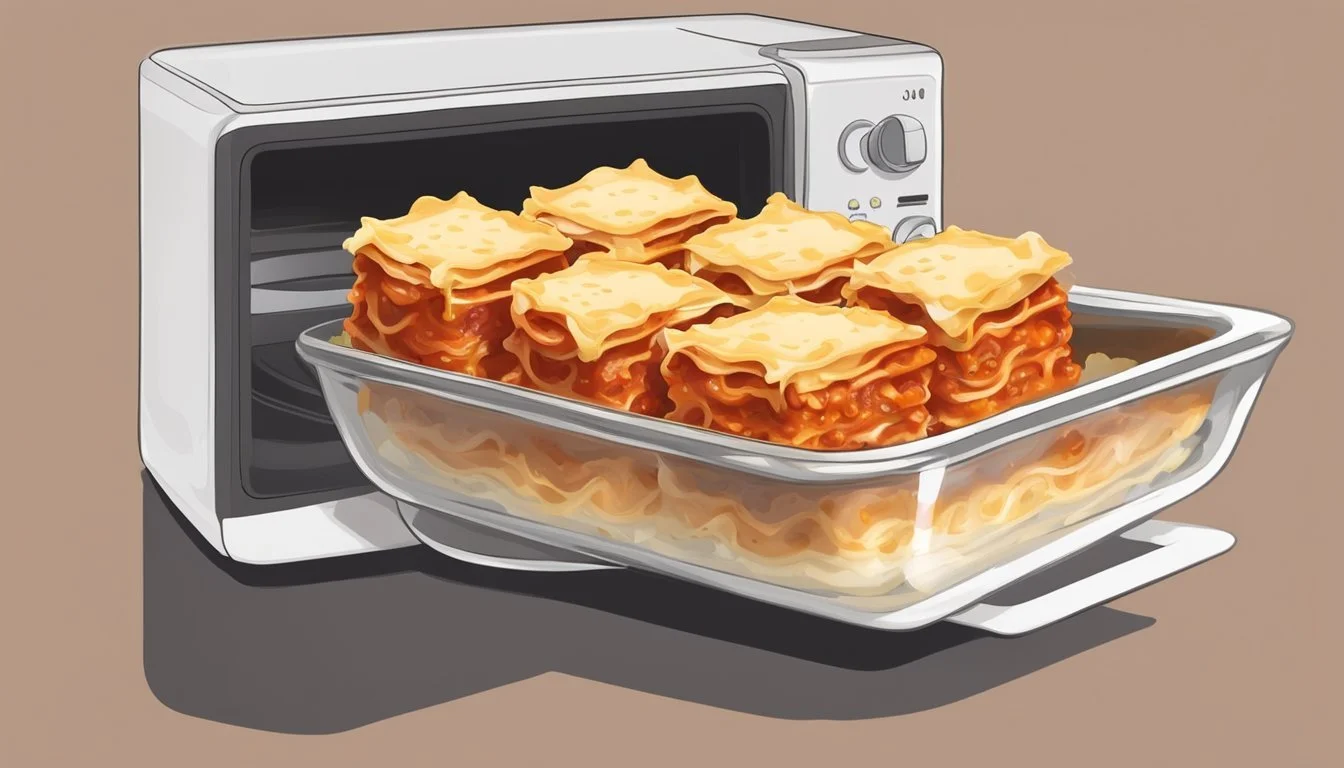Best Way to Reheat Lasagna Rolls
Tips for Perfect Cheesy & Saucy Results
Reheating lasagna rolls while maintaining their delightful cheesy and saucy qualities can be a challenge. Lasagna leftovers often lose their texture and flavor when reheated improperly. But with the right technique, one can enjoy lasagna rolls that are just as satisfying as when they first came out of the oven. The key lies in preserving the moisture and ensuring an even distribution of heat.
Lasagna rolls, with their spiral layers of pasta, cheese, and sauce, are particularly prone to drying out or becoming too soggy when reheated. The technique used must therefore strike a balance, retaining the dish's inherent creaminess without compromising its structural integrity. Whether using a microwave, oven, or stovetop, there are methods to help achieve the perfect reheat.
Careful attention to detail can turn leftover lasagna rolls into a second meal that rivals the original in taste and texture. It's crucial to cover the rolls to trap steam and keep them moist, add a bit of water or sauce to replenish lost moisture, and heat them slowly and gently. Monitoring the temperature ensures the lasagna is heated through to the ideal internal temperature, safeguarding both the quality of the dish and food safety standards.
Understanding Lasagna Composition
Lasagna is a sumptuous layered dish that owes its rich flavors and textures to three fundamental components: cheese, pasta, and sauce.
Cheese: It's a binding agent that provides lasagna with its trademark gooeyness and rich taste. Predominant cheese types used include Ricotta, which lends creaminess, and Mozzarella, known for its superior melting qualities and stretchiness. Parmesan, on the other hand, imparts a salty, umami flavor that enhances the overall taste profile of the dish.
Pasta: Lasagna noodles form the structural layers of the dish. They are typically broad and flat, designed to hold up the weight of the cheeses and sauce. Once cooked, they should be tender, yet resilient enough to not become overly mushy when reheated.
Sauce: The sauce acts as a culinary glue, marrying the cheese and noodles while also contributing moisture and flavor. Common varieties include:
Traditional tomato-based marinara, rich in tang and sweetness.
Creamy béchamel, lending a velvety smooth texture.
To maintain the integrity of these elements upon reheating, one must be mindful of moisture content and heat distribution:
Cheese: Avoid excessive dryness or burning by using moderate heat.
Pasta: Prevent the noodles from drying out by adding a small amount of liquid if necessary.
Sauce: Ensure it remains evenly distributed to avoid dry spots, helping retain the dish's sauciness.
Properly reheated lasagna should showcase melted cheese, tender yet firm pasta, and a sauce that remains integral to the roll, complementing each bite.
Preparation for Reheating
Proper preparation is essential for ensuring lasagna rolls are reheated to cheesy perfection while maintaining their saucy appeal. Attention to the thawing process and selection of an appropriate container can significantly influence the reheating outcome.
Thawing Lasagna Rolls Properly
When working with frozen lasagna rolls, thawing them correctly is crucial to avoid a temperature shock that could affect their texture and taste. For the best results, lasagna rolls should be transferred from the freezer to the fridge at least 24 hours before reheating. This slow defrosting method helps maintain the integrity of the lasagna rolls, ensuring that they reheat evenly and retain their moisture.
Thawing Timeframe:
Freezer to Fridge: Approximately 24 hours before reheating.
Room Temperature: Only for quick defrosting if necessary and should not exceed two hours for food safety reasons.
Choosing the Right Container
Selecting the right container is vital to preserve the characteristics of leftover lasagna, especially its cheesy and saucy elements. For oven reheating, an oven-safe dish is ideal, preferably made of glass or ceramic. To keep the lasagna rolls moist, cover them with aluminum foil. If you're using a microwave, place the rolls in a microwave-safe dish and cover them with plastic wrap to trap steam and prevent drying.
Container Materials:
Oven: Glass or ceramic dish, covered with aluminum foil.
Microwave: Microwave-safe dish, covered with plastic wrap.
Container Tips:
Make sure the container is airtight if you don't plan to reheat immediately after thawing.
If transferring directly from fridge to oven or microwave, ensure the container is also fridge-safe.
By adhering to these preparatory steps, one can maximize the chances of enjoying lasagna rolls that are as enjoyable as when they were first baked.
Reheating Methods
To ensure lasagna rolls remain flavorful and retain their texture, selecting the appropriate reheating method is crucial. Whether aiming for a crispy top layer or a consistently heated filling, these techniques offer various benefits to suit different preferences.
Oven Reheating Technique
When reheating lasagna rolls in an oven, the process helps to keep the dish moist and preserve its taste. Preheat the oven to 375°F (190°C). If the lasagna is frozen, additional cooking time is required. Place the rolls in a baking dish, cover with foil to prevent drying out, and heat until the internal temperature reaches 165°F (74°C). This oven method typically takes about 25 minutes.
Microwave Reheating Steps
For a quick option, the microwave can reheat lasagna rolls efficiently. Place the rolls in a microwave-safe dish, cover with a damp paper towel to maintain moisture, and use a medium setting to reheat. Check the lasagna every 30 seconds to avoid overheating and continue until it's thoroughly warmed, usually within 1 to 2 minutes.
Stovetop Reheating Process
Using a stove, specifically with a skillet or a cast-iron skillet, can bring lasagna rolls back to a deliciously warm state. Introduce a small amount of water to the skillet to add moisture and cover with a lid, creating a steaming effect. Heat on medium-low for 15 to 20 minutes, occasionally shaking the pan to distribute heat evenly.
Utilizing Air Fryer for Reheating
An air fryer is excellent for achieving a crispy top layer without compromising the texture of the lasagna rolls. Preheat the air fryer to 350°F (175°C). Place the rolls in the basket and heat for about 5 to 7 minutes, ensuring the final product is warmed through for optimal taste.
Toaster Oven Reheating Tips
A toaster oven provides a balance between the microwave's swiftness and the oven's thoroughness. It's ideal for reheating lasagna rolls with a preference for crispy edges. Preheat to 375°F (190°C) and arrange the rolls in a toaster-safe dish. Cover with foil and heat for 25 to 30 minutes, observing the texture to your preference.
Ensuring Quality and Safety
When reheating lasagna rolls, ensuring that the dish maintains its savory qualities while adhering to food safety standards is paramount. Achieving the perfect internal temperature and preserving the dish’s moisture and texture are crucial steps.
Checking Internal Temperature
One must ensure that the reheated lasagna reaches a safe internal temperature of 165°F (74°C) to eliminate harmful bacteria. It is advisable to use a meat thermometer to check the temperature at the center of the lasagna roll. The temperature check is particularly important if the lasagna contains meat, which can harbor bacteria like E. coli and Salmonella if not properly reheated.
Maintaining Moisture and Texture
To preserve the lasagna's taste and quality, attention needs to be given to maintaining moisture and texture:
Moisture: Prevent the lasagna from drying out by covering it with aluminum foil during reheating. Alternatively, add a bit of water or sauce on top before covering. This creates a steaming effect that keeps the rolls succulent.
Texture: The lasagna edges can become hard and unpleasant if overexposed to heat. Ensuring the lasagna is covered throughout the reheating process helps protect the texture of the edges.
Steaming: For those reheating in a skillet, one can introduce a small amount of water around the lasagna and cover it with a lid to create a gentle steaming environment that heats the lasagna evenly without making it too soggy or losing its structural integrity.
Storing Lasagna Rolls
Properly storing lasagna rolls ensures they retain their quality when refrigerated or frozen. It safeguards against bacteria and preserves the dish's integrity for future meals.
Methods to Freeze Lasagna Properly
When meal prepping or saving leftovers, one can freeze lasagna rolls to extend their shelf life. To freeze lasagna:
Wrap each roll individually in plastic wrap. This guards against freezer burn and flavor transfer.
Place the wrapped rolls in an airtight container or a resealable freezer bag.
Label the container with the date to track how long the lasagna rolls have been frozen.
Lasagna rolls can be safely frozen for up to three months. Thawing them in the refrigerator overnight before reheating is recommended for optimal texture and flavor.
Refrigeration Best Practices
For lasagna rolls that will be eaten within a few days, refrigeration is the best storage method:
Allow leftovers to cool to room temperature before storing to prevent condensation that can encourage bacterial growth.
Wrap the lasagna rolls in plastic, or cover them with aluminum foil.
Place the wrapped rolls in an airtight container to maintain freshness and prevent the absorption of strong odors from the fridge.
Lasagna rolls should be consumed within three to five days when refrigerated. Always check the dish before reheating to ensure it has maintained its quality and shows no signs of spoilage.
Serving Suggestions and Enhancements
When reheating lasagna rolls to achieve that perfect balance of cheesy goodness and saucy appeal, one might consider adding extra cheese and sauce or pairing them with complementary side dishes.
Adding Extra Cheese and Sauce
Lasagna rolls can benefit from a bit of additional cheese and sauce to refresh the flavors and moisture that may have been lost during refrigeration. Before reheating, drizzle some extra sauce over the rolls to keep them moist. Then, sprinkle a blend of mozzarella and parmesan cheese on top to enhance the taste and create a gooey, delightful texture.
Complementary Side Dishes
A lasagna roll serves as a hearty and complete meal by itself, but one can elevate the dining experience with a few well-chosen side dishes. Consider the following options to complement the rich flavors of lasagna rolls:
Salad: A fresh green salad with a vinaigrette dressing to cut through the richness of the lasagna rolls.
Bread: A crusty piece of garlic bread or focaccia to mop up any remaining sauce and add a satisfying crunch.
Vegetables: Steamed or roasted vegetables, like asparagus or bell peppers, can add a healthy and colorful component to the meal.
Pesto: For a flavor twist, a dollop of basil pesto on the side could serve as a zesty accompaniment.
Serving lasagna rolls with these side dishes not only visually appeals but also enhances the overall taste experience, making the meal satisfying and well-rounded.
Conclusion
When reheating lasagna rolls to maintain their appetizing texture and flavor, precision is key. Microwave reheating is suitable for saving time, with a sprinkling of water and heating in increments until the internal temperature reaches 165°F. One must let the lasagna stand briefly before serving to ensure even heat distribution.
If one prefers a crispier bottom, pan reheating with a dash of water covered with a lid may be preferred. An average of 20 minutes on medium-low heat, occasionally shaking the pan, followed by a brief period without the lid may achieve this effect.
For those seeking to employ kitchen gadgets, the air fryer provides a rapid method. Preheating it to 350°F and cooking the rolls for 5-7 minutes should suffice for a thoroughly heated dish.
In any method, one must remember that lasagna rolls are delicate and can dry out or become soggy if not monitored. The following top tips ensure a desirable outcome:
Always add a small amount of water or sauce to maintain moisture.
Cover the lasagna rolls during most of the reheating process to trap steam.
Check the temperature to avoid overcooking.
They should be mindful to cool the lasagna rolls momentarily post-reheat for a flawless culinary experience. By following this summary of key steps, reheated lasagna rolls can rival their freshly baked counterparts in both taste and texture.




